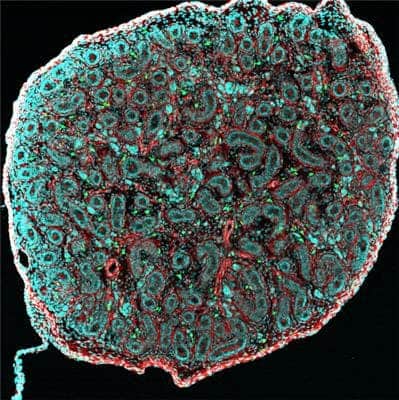Two types of testicular macrophage — important cells of the immune system — have been described in great detail by French researchers at the Centre d’Immunologie de Marseille-Luminy. These specialized cells that recognize, engulf and destroy target cells are believed to act like a sort of guardians of fertility. As such, this effort will help us better understand what causes male infertility and might lead to innovative treatments.

Cross section of newborn mouse’s testis (Ø = 20 µm), where we can see the seminiferous tubules (red) surrounded by macrophages (green). Confocal micrograph. © Noushine Mossadegh-Keller and Sébastien Mailfert / CIML
Our immune system is critical to our survival. This is why AIDS is such a terrible disease — it’s not the infection itself that kills you but everything else that would normally fly by since the immune system is now superseded. Its primary role is to 1) distinguish native cells and 2) identify, then seek and destroy potentially pathogen foreign cells.
Meet the sperm guard
Technically, though, spermatozoa are also foreign cells. It can take at least a dozen years before puberty sets in and sperm is finally produced by the male testis. Typically, the sperm should be identified as an intruder by certain immune system elements and destroyed. Obviously, this doesn’t happen otherwise there would be no more babies in the world, or you and me for that matter.
This is where the testicular macrophages come in. A macrophage is a large white blood cell which gobbles foreign pathogens like bacteria. Not only do they act as antimicrobial warriors, they also play critical roles in immune regulation and wound-healing. Macrophages exist in nearly all tissues and are produced when white blood cells called monocytes leave the blood and differentiate in a tissue-specific manner. Depending on where they’re made and where they function, macrophages come in different types and bear different names. For example, macrophages present in the brain are termed microglia and in the liver sinusoids they are called Kupffer cells.
In human male testicles, scientists have identified two types of macrophages, each originating in one of the two compartments of the testis. In the so-called interstitial space, where we can find the testosterone-producing Leydig cells, one type of interstitial macrophages is produced. These are made from embryonic cells and are present from the beginning of an individual’s life. The other kind of macrophage is peritubular, named so because we can find it on the surface of seminiferous tubules that house sperm cell precursors.
Studying mice, the French researchers led by Michael Sieweke found peritubular macrophages only appear two weeks after the mice were born, which coincides with the rodent’s puberty. After puberty sets in, the peritubular macrophages stay with them for the rest of their lives, as reported in the Journal of Experimental Medicine.
“We show that embryonic progenitors give rise to the interstitial macrophage population, whereas peritubular macrophages are exclusively seeded postnatally in the prepuberty period from bone marrow (BM)–derived progenitors. As the proliferative capacity of interstitial macrophages declines, BM progenitors also contribute to this population. Once established, both the peritubular and interstitial macrophage populations exhibit a long life span and a low turnover in the steady state,” the authors wrote.
Sieweke’s team now wants to focus on the relationship between macrophages, sperm, and testosterone production. This investigation might one day enable innovative treatments for certain kinds of male infertility.









